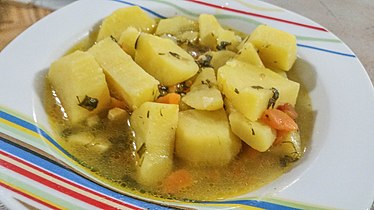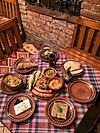Yahni
 Beef yahnia in North Macedonia | |
| Alternative names | Yahni, yahnia, jahni, yakhna, yakhnia, iahnie |
|---|---|
| Type | stock, broth, or soup |
| Main ingredients | lamb meat or mutton meat |
Yakhni (Persian: یخنی,[1] Arabic: يخني, Urdu: یخنی, Hindi: यख़नी, Greek: γιαχνί[2]), yahni (Turkish[3]), or yahniya (Bulgarian: яхния, Serbian, Macedonian: јанија), jahni (Albanian[4]) is a class of dishes traditionally prepared in a vast area encompassing South Asia, the Middle East and the Balkans.[5]
History
[edit]A meat stew named yakhni originated as a Medieval Iranian cuisine. The name derives from the covered clay pot in which it was originally cooked.[5] The meaning of the Persian word is "store of food".[5][1] Different varieties of this dish later spread eastwards to Afghanistan, Uzbekistan and South Asia and westwards to the Ottoman Empire reaching the Levant and the Balkans.[5]
Varieties
[edit]This section needs additional citations for verification. Please help improve this article by adding citations to reliable sources in this section. Unsourced material may be challenged and removed. Find sources: "Yahni" – news · newspapers · books · scholar · JSTOR (March 2013) (Learn how and when to remove this message) |
In Iranian cuisine, yakhni is a meat stew akin to khoresh, while yakhni-polow is a pilaf cooked in a stew.[5]
In Arab (especially Palestinian), Albanian, Greek, and Turkish cuisines, it is a stew of meat, fish, or vegetables in a browned-onion base with tomatoes and olive oil. In Bulgarian cuisine, sunflower oil is used instead of olive oil.
In Romanian cuisine, the term iahnie de fasole refers to a style of baked beans, often cooked or served with smoked meat and sausages (fasole cu cârnați).
In Pakistan and India, yakhni refers to stock or broth of beef, chicken, lamb or mutton.[6] It is touted for its health benefits[7] and is often the base for many foods including pulao[8] (a pilaf) and other shorbas (soups).
In Bangladesh, akhni is a mixed rice dish and variant of the biryani and polao dishes.
A version of the dish is also part of the Romani cuisine.[9]
References
[edit]- ^ a b Francis Joseph Steingass (2018) [1892]. Persian-English Dictionary. Routledge. p. 1529. ISBN 9781136852480.
- ^ "Dictionary of Standard Modern Greek". www.greek-language.gr. Retrieved 2021-01-12.
- ^ Alan Davidson (11 August 2014). The Oxford Companion to Food. Oxford University Press. p. 117. ISBN 978-0-19-967733-7.
- ^ Osmani, Shqipe (2024-06-06). "Jahnia e traditës e shëndetshme e shije në tryezë". Kosovapost.net (in Albanian). Retrieved 2024-06-11.
- ^ a b c d e Marks, Gil (2010). Encyclopedia of Jewish Food. Hoboken: John Wiley & Sons. ISBN 978-0-470-39130-3.
- ^ Jamil, Tressa (2021-12-29). "Yakhni (Bone Broth)". Jamil Ghar. Retrieved 2022-11-28.
- ^ Yasin, Aamir (2014-12-22). "Chicken Yakhni — a nutritious winter tradition". DAWN.COM. Retrieved 2022-11-28.
- ^ Jamil, Tressa (2022-11-07). "Yakhni Pulao". Jamil Ghar. Retrieved 2022-11-28.
- ^ Sullivan, Meghan Collins (16 May 2014). "Introducing Roma Cuisine, The Little-Known 'Soul Food' Of Europe". NPR. Retrieved May 10, 2021.
- CS1 Albanian-language sources (sq)
- Articles with short description
- Short description matches Wikidata
- Articles containing Persian-language text
- Articles containing Arabic-language text
- Articles containing Urdu-language text
- Articles containing Hindi-language text
- Articles containing Greek-language text
- Articles containing Bulgarian-language text
- Articles containing Macedonian-language text
- Articles needing additional references from March 2013
- All articles needing additional references







